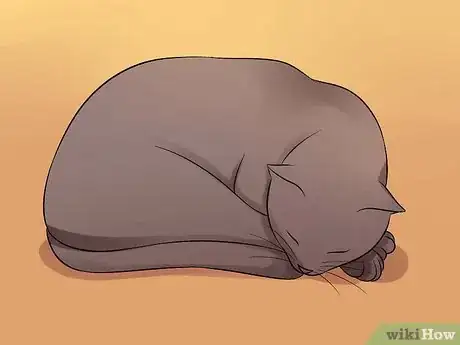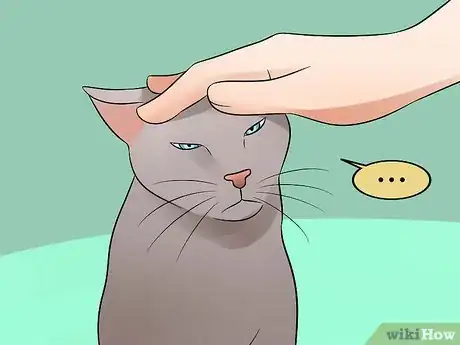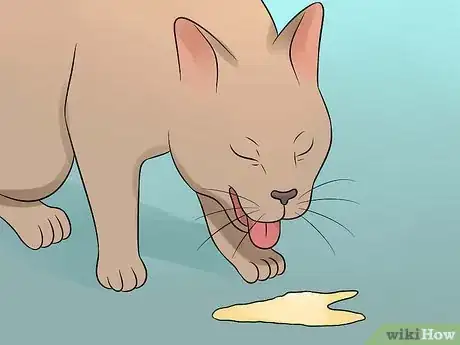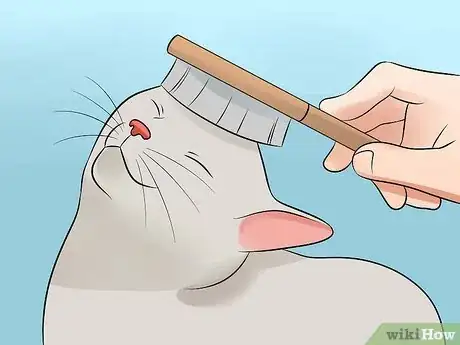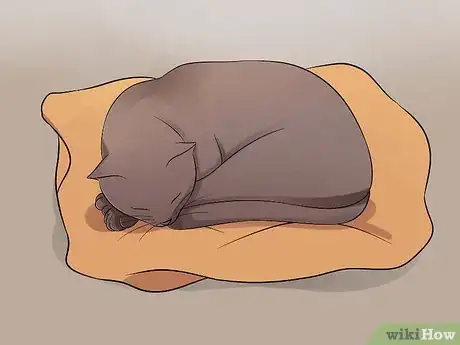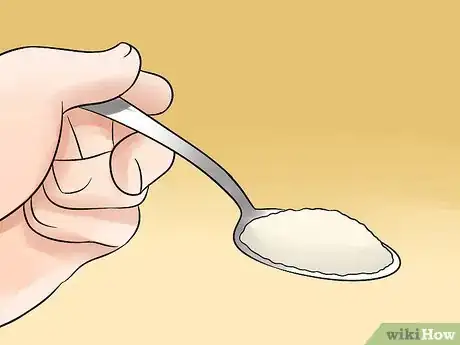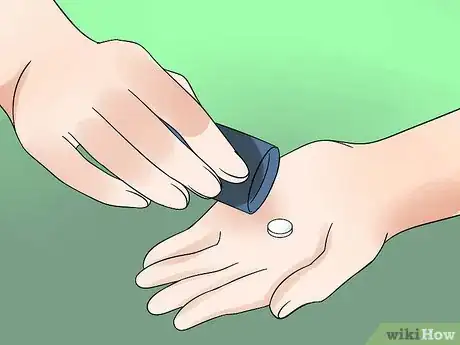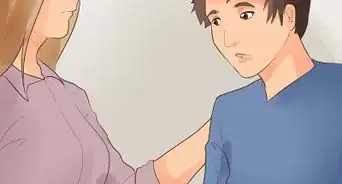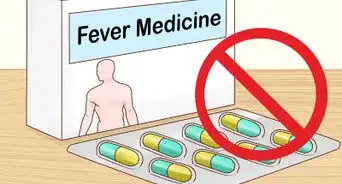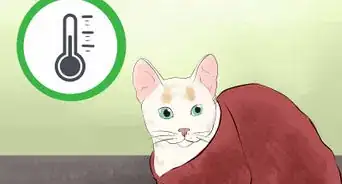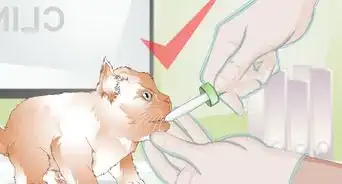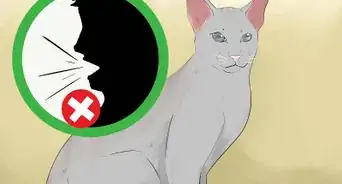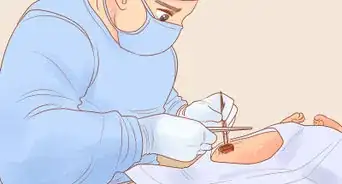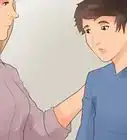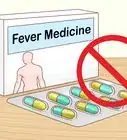This article was co-authored by Deanne Pawlisch, CVT, MA. Deanne Pawlisch is a Certified Veterinary Technician, who does corporate training for veterinary practices and has taught at the NAVTA-approved Veterinary Assistant Program at the Harper College in Illinois and in 2011 was elected to the board of the Veterinary Emergency and Critical Care Foundation. Deanne has been a Board Member of the Veterinary Emergency and Critical Care Foundation in San Antonio, Texas since 2011. She holds a BS in Anthropology from Loyola University and an MA in Anthropology from Northern Illinois University.
This article has been viewed 49,821 times.
Just like any other creature, cats can be affected by changes in their circumstances, environment, or routine. Maybe their owner has returned to work after a home leave, they are staying in the cattery, or are being put on a new diet. All of these things represent stress in a cat's life, and one response to stress is depression.
Steps
Part 1: Recognizing the Signs of Depression
-
1Notice if your cat stops eating and spends more time than usual sleeping. The majority of depressed cats withdraw into themselves and don’t bother eating or have energy to do much more than sleep.[1]
-
2Check if your cat has stopped using her litter box. Some depressed cats will go on a dirty protest, meaning they won’t bother with using their litter box and instead start soiling the house.[2]Advertisement
-
3Notice if your cat does not purr when you pet her or touch her. She may refuse or neglect to respond to you when you make a fuss over her.[3]
- She may also lose interest in playing with her favorite toy or fail to be engaged by her favorite activities or games.
-
4Think about any major recent changes in your cat’s life. This could be the arrival of a new pet in her home or turf or the loss of a close companion like a fellow pet or other owner.[4]
-
5Pay attention to symptoms that may indicate a physical illness, rather than depression. Try to distinguish between psychological symptoms and a physical illness.[5]
- If your cat displays symptoms like increased thirst, altered appetite (decreased or increased), changes in bowel movements (diarrhea or constipation), and other physical abnormalities such as vomiting or sneezing, these may all be signs of a physical illness.
- It can be difficult to distinguish psychological issues and physical illness in your cat, as there is a big overlap with the quiet behavior of a depressed cat and a cat that is ill. So, if your cat starts behaving oddly in any way, get her checked out by the vet to ensure she is not sick. From this diagnosis, you can consider if your cat is in fact depressed.
Part 2: Using Bonding Techniques and TLC
-
1Encourage her, rather than force her, to cheer up. Remember to respect your cat’s independent nature and never force her to socialize or engage with you or other cats, as this will likely make her more upset, rather than cheer her up.[6]
- Use treats to motivate her to play or move around, but do not use physical force.
-
2Establish a daily routine for your cat. Cats like security and routine. So if there has been a major change, such as your absence after working from home for a long period of time, try to establish a new routine to help her adapt.[7]
- Provide events for the cat to look forward to, such as mealtimes before you go to work and when you return, a grooming session before bedtime, and a play session when you get home from work.
-
3Set aside time every day to groom your cat. Grooming helps your cat to bond with you. Not only will your cat feel physically better about herself but she'll feel more secure and reassured.[8]
- Ideally, have a grooming at a similar time every day to build that sense of routine and security.
-
4Have play sessions with your cat. Though your cat may initially not want to get up or play with you, provide her with the opportunity anyway.[9]
- Introduce a new toy, especially one that triggers natural hunting behavior like a mouse on a string.
- Be patient if she does not react right away. Start by putting the toy near her paw and jerking it to encourage hunting behavior. Do this for five minutes, even if your cat doesn't respond. The fact that you are giving her your undivided attention will make an impression on her.
- Once she starts to play, this will engage her hypothalamus and send out hormones that are beneficial for counteracting depression. An active cat is a happy cat.
-
5Give your cat an item of your clothing to sleep on. This will help to remind her of your presence as the item will have your scent on it. This will also hopefully reassure your cat and provide a sense of security for her.[10]
-
6Gently interact and talk to her. While you don’t want to crowd her or persist in pursuing her if she is under the bed or in a hiding spot, you can lie down on the floor beside the bed or near her and talk to her soothingly.[11]
- You can also try to tempt her to come out from hiding with a treat or irresistible snack that she likes.
-
7Be consistent with your TLC. Just like in humans, depression isn’t an easy thing to cure or solve. By being consistent with your attentions and TLC, every day, week after week, your cat should eventually warm up to your actions and respond to your attempts at cheering her up.
Part 3: Using Supplements and a Natural Remedy
-
1Purchase Feliway, which contains a synthetic feline facial pheromone. This is a similar pheromone to the hormones that help a cat to feel safe, secure, and content.[12]
- Though Feliway won't provide a quick fix as it typically takes a couple of weeks to make any visible difference on a cat's behavior, it does work slowly to reassure your cat and reduce her anxiety.
-
2Apply Feliway as a cream or use it as a spray or a room diffuser. The cream version is commonly used by veterinarians before handling anxious patients. But the room diffuser is probably most useful for your depressed cat because you can plug the diffuser unit into an electrical socket in the room where your cat spends most of her time. As the cat sleeps, she will breathe in the pheromone.
- Don't worry, these diffusers are odorless to people and have no effect on humans.
-
3Consult your veterinarian about a food supplement, such as nutraceuticals. These food supplements can have health benefits that are similar to those found in pharmaceuticals but with fewer side effects.[13]
- Before using these supplements, consult a veterinarian who prescribes them to cats a regular basis. Just because a supplement is not a prescription drug doesn't mean it is free of side effects.
- The nutraceutical Zylkene has been developed to decrease stress in cats. As stress is a major cause of feline depression, decreasing this can help get your cat back on her paws.
- Zylkene contains a molecule derived from milk, which acts on the brain receptors. It has a similar calming effect to certain prescription medications but with fewer potential side effects. This will help to soothe your cat’s anxiety and reduce her fears, both of which are powerful drivers for depression.
- The effect of nutraceuticals are not rapid, so it can take up to seven days before you notice any clear differences in your depressed kitty.
- Zylkene comes as a capsule. The dose for an average-sized cat is one 75mg capsule once a day.
-
4Use an unverified natural remedy like valerian extract. There are no scientific studies that back up the benefits of this herbal remedy, but anecdotally some pet owners swear by the effectiveness of valerian extract on depression and stress in a cat.
- Giving supplements should always be done under the advice of an integrative veterinarian. Talk to your vet before pursuing natural remedies.
- Dorwest Valerian Drops come in a dropper bottle. A quarter of a teaspoon can be added to your cat’s food once or twice daily or dropped onto her bedding.
- An alternative is Skullcap and Valerian tablets, also by Dorwest Herbs, with a total daily dose of two tablets.
Part 4: Giving Your Cat Medication
-
1Get a prescription from your vet for Clomipramine. This drug belongs to the tricyclic antidepressant group, and there is a licensed veterinary version available, which makes this drug the first and ideal choice for your vet to prescribe. Clomipramine acts by inhibiting the reuptake of certain neurotransmitters by tissue, which prolongs their effects in the circulation.[14] It also reduces urine spraying in cats, which is another symptom of depression.[15]
- Your vet will prescribe a total dose of 2- 4 mg once a day. The smallest tablet is 5mg so an ideal starting dose is half a tablet a day.
-
2Ask your vet for a prescription for Amitriptyline. This drug has a complex mode of action but helps to increase levels of neurotransmitters in the brain, mainly serotonin and norepinephrine, that are associated with feelings of wellbeing. Amitriptyline is a human prescription medication, so needs to be prescribed by your veterinarian.[16]
- The prescribed dose is 5-10 mg per cat once daily.
- The smallest available tablet is 10mg so this is equivalent to taking half or one tablet a day.
-
3Talk to your vet about a prescription for Fluoxetine (Prozac) and Paroxetine (Paxil). These are both prescription medications designed to treat depression in humans. Both drugs are selective serotonin reuptake inhibitors (SSRIs) which help maintain raised levels of the beneficial neurotransmitter serotonin.[17]
- The prescribed dose of fluoxetine is 2.5-5 mg per cat (a quarter to half of a 8 mg tablet) once a day.
- The prescribed dose of paroxetine is also 2.5 - 5 mg per cat (a quarter to half of a 10 mg tablet) once a day.
- Keep in mind that it may take two weeks before therapeutic levels are reached in the blood stream.
-
4Use stealth and persistence to get your cat to take medication. The ability cats have to avoid taking medication is legendary. You may succeed either by stealthily hiding the tablet in a cube of chicken or cheese.
- If this fails, try popping the pill directly into her mouth and over the back of her tongue. Syringe a teaspoon of water into her mouth afterwards to make sure she has swallowed the pill all the way down.
-
5Never share your medication with your cat. Though several of the drugs available for humans can also be prescribed for your cat, frequently the tablets prescribed for people are many times stronger than those used for a cat and you stand a good chance of overdosing your cat.
- Giving your medication to your cat also means you be short on your own daily dose.
References
- ↑ Feline Behavior for the Veterinarian. Bonnie Beaver. WB Saunders. 2nd edition
- ↑ Feline Behavior for the Veterinarian. Bonnie Beaver. WB Saunders. 2nd edition
- ↑ Feline Behavior for the Veterinarian. Bonnie Beaver. WB Saunders. 2nd edition
- ↑ Feline Behavior for the Veterinarian. Bonnie Beaver. WB Saunders. 2nd edition
- ↑ Feline Behavior for the Veterinarian. Bonnie Beaver. WB Saunders. 2nd edition
- ↑ Feline Behavior for the Veterinarian. Bonnie Beaver. WB Saunders. 2nd edition
- ↑ Feline Behavior for the Veterinarian. Bonnie Beaver. WB Saunders. 2nd edition
- ↑ Feline Behavior for the Veterinarian. Bonnie Beaver. WB Saunders. 2nd edition
- ↑ Feline Behavior for the Veterinarian. Bonnie Beaver. WB Saunders. 2nd edition
- ↑ Feline Behavior for the Veterinarian. Bonnie Beaver. WB Saunders. 2nd edition
- ↑ Feline Behavior for the Veterinarian. Bonnie Beaver. WB Saunders. 2nd edition
- ↑ Feline Behavior for the Veterinarian. Bonnie Beaver. WB Saunders. 2nd edition
- ↑ Feline Behavior for the Veterinarian. Bonnie Beaver. WB Saunders. 2nd edition
- ↑ Clomipramine. Plumb's Veterinary Drug Handbook. location 17065
- ↑ http://avmajournals.avma.org/doi/abs/10.2460/javma.2004.225.881
- ↑ Amitriptyline. Plumb's Veterinary Drug Handbook.
- ↑ Paroxetine. Plumb's Veterinary Drug Handbook. Location 54242
About This Article
To help your depressed cat, try to establish a routine for it, especially if there's been a recent major change in its life. For example, you could establish regular mealtimes and grooming sessions so your cat has things to look forward to. Also, try to set aside time every day to play with your cat since playing releases hormones that help counteract depression. Even just spending time with your cat and talking to it in a soothing voice can help it feel loved and less depressed. For more advice from our Veterinary co-author, like how to use supplements and medication to combat feline depression, scroll down.
